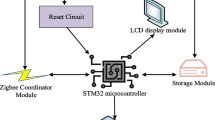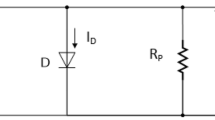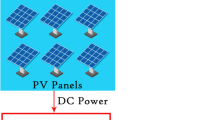Abstract
In this paper, artificial neural network (ANN) and adaptive neuro-fuzzy inference system (ANFIS) are used as maximum power point tracking controllers to improve the performance of a stand-alone photovoltaic system. Based on the FL-M-160W PV module specifications, the PV panel and the boost converter were modeled in MATLAB/Simulink environment. Using a set of data collected during the experimental phase, the developed ANN and ANFIS-MPPT controllers have being learn, test and validate offline then inserted into the PV system. These controllers deliver at output an optimal voltage which will be compared to the reference voltage supplied by the photovoltaic generator and the error obtained will be used to adjust the duty cycle of the converter boost located between the PV panel and the load. It is shown after simulations that ANN and ANFIS-MPPT controllers are more robust and can follow the maximum power point with very low recovery time and low oscillations around the operating point in both in stable and changing atmospheric conditions.

















Similar content being viewed by others
References
Lashab, A., Bouzid, A., Snani, H.: Comparative study of three MPPT algorithms for a photovoltaic system control. In: 2015 World Congress on Information Technology and Computer Applications (WCITCA) (2015)
Jiyong, L., Honghua, W.: Maximum power point tracking of photovoltaic generation based on the fuzzy control method. IEEE Supergen 9, 1–6 (2009)
Singh, G.: Solar power generation by PV (photovoltaic) technology: a review. Energy 53, 1–13 (2013)
Koutroulis, E., Kalaitzakis, K., Voulgaris, N.C.: Development of a microcontroller-based photovoltaic maximum power point tracking control system. IEEE Trans. Power Electron. 16(1), 46–54 (2001)
Femia, N., Petrone, G., Spagnuolo, G., Vitelli, M.: Optimization of perturb and observe maximum power point tracking method. IEEE Trans. Power Electron. 20(4), 963–973 (2005)
Ait-Cheikh, M.S., Larbes, C., Tchoketch, G.F., Zerguerras, A.: Maximum power point tracking using fuzzy logic controller scheme. J. Renew. Energy 10, 387–395 (2007)
Nzoundja, F.C.B., Kamta, M., Wira, P.: A comprehensive assessment of MPPT algorithms to optimal power extraction of a PV panel. J. Sol. Energy Res. 4(3), 172–179 (2019)
Liu, F., Kang, Y., Zhang, Y., Duan, S.: Comparison of P&O and hill climbing MPPT methods for grid-connected PV converter. In: Proceedings of the 3rd IEEE Conference on Industrial Electronics and Applications, 2008 (ICIEA 2008), pp. 804–807 (2008)
Salman, S., Ai, X., Wu, Z.: Design of a P-&-O algorithm based MPPT charge controller for a standalone 200W PV system. Prot. Control Mod. Power Syst. 3(25), 1–8 (2018)
Femia, N., Petrone, G., Spagnuolo, G., Vitelli, M.: A technique for improving P&O MPPT performances of double-stage grid-connected photovoltaic systems. IEEE Trans. Ind. Electron. 56(11), 4473–4482 (2009)
Belkaid, A., Colak, I., Isik, O.: Photovoltaic maximum power point tracking under fast varying of solar radiation. Appl. Energy 179, 523–530 (2016)
Ankaiah, B., Nageswararao, J.: MPPT algorithm for solar photovotaic cell by incremental conductance method. Int. J. Innov. Eng. Technol. 2(1), 17–23 (2013)
Bebis, G., Georgiopoulos, M.: Feed-forward neural networks: why network size is so important. IEEE Potentials 13, 27–31 (1994)
Boitier, V., Maussion, P., Cabal, C.: Recherche du maximum de puissance sur les générateurs photovoltaïques. Revue 3EI 54, 90–96 (2008)
Farhat, S., Alaoui, R., Kahaji, A., Bouhouch, L.: Estimating the photovoltaic MPPT by artificial neural network. In: International Renewable and Sustainable Energy Conference (IRSEC) (2013)
James, E.A., Jasmin, J.: Implementation of fuzzy logic based maximum power point tracking in photovoltaic system. In: Proceedings of the International Conference on Control, Communication and Power Engineering, CCPE, pp. 546–556. Elsevier (2014)
Harrag, A., Messalti, S.: Variable step size modified P&O MPPT algorithm using GA-based brid offline/online PID controller. Renew Sustain Energy Rev. 49, 1247–1260 (2015)
Tse, K.K., Ho, M.T., Chung, H.S., Hui, S.Y.R.: A comparative study of maximum-power-point trackers for photovoltaic panels using switching-frequency modulation scheme. IEEE Trans. Ind. Electron. 51(2), 410–418 (2004)
Yong, Z., Hong, L., Liqun, L., Xiao, G.: The MPPT control method by using BP neural networks in PV generating system. In: Proceedings of the 2012 International Conference on Industrial Control and Electronics Engineering (2012)
Xiao, G.W., Dunford, W.: A modified adaptive hill climbing MPPT method for photovoltaic power systems. In: Proceedings of the 35th Annual IEEE Power Electronics Specialists Conference, pp. 1957–1963 (2004)
Messalti, S., Harrag, A., Loukriz, A.: A new variable step size neural networks MPPT controller: review. Renew Sustain Energy Rev. 68, 221–233 (2017)
Hussein, K.H., Muta, I., Hoshino, T., Osakada, M.: Suivi de la puissance photovoltaïque maximale: un algorithme pour des conditions atmosphériques en évolution rapide. IEE Proc Gener Transm Distrib. 142, 59–64 (1995)
Reisi, A.R., Moradi, M.H., Jamas, B.S.: Classification and comparison of maximum power point tracking techniques for photovoltaic system: a review. Renew. Sustain Energy Rev 19, 433–443 (2013)
Mokhtar, M., Marie, M.: Engineering Applications of Matlab 5.3 and Simulink3, p. 538. Springer, London (2000)
Krishna, S., Padiyar, K.R.: Transient stability assessment using artificial neural networks. IEEE Trans. Power Syst. 1, 627–632 (2000)
Rai, A.K., Kaushika, N.D., Singh, B., Agarwal, N.: Simulation model of ANN based maximum power point tracking controller for solar PV system. Sol. Energy Mater. Sol. Cells 95, 773–778 (2011)
Al-Majidi, S.D., Abbod, M.F., Al-Raweshidy, H.S.: Design of an efficient maximum power point tracker based on ANFIS using an experimental photovoltaic system data. Electron. MDPI 8(858), 20 (2019)
Kulaksiz, A.A.: ANFIS-based estimation of PV module equivalent parameters: application to a stand-alone PV system with MPPT controller. Turk. J. Electr. Eng. Comput. Sci. 21, 2127–2140 (2013)
Roger, J.-S.J.: ANFIS: adaptive-network-based fuzzy inference system. IEEE Trans. Syst. Man Cybern. 23(3), 665–685 (1993)
Zhang, L., Xiong, G., Zou, H., Weizhong, G.: Bearing fault diagnosis using multi-scale entropy and adaptive neuro-fuzzy inference. Expert Syst. Appl. 37, 6077–6085 (2010)
Author information
Authors and Affiliations
Corresponding author
Additional information
Publisher's Note
Springer Nature remains neutral with regard to jurisdictional claims in published maps and institutional affiliations.
Rights and permissions
About this article
Cite this article
Kuate Nkounhawa, P., Ndapeu, D. & Kenmeugne, B. Artificial neural network (ANN) and adaptive neuro-fuzzy inference system (ANFIS): application for a photovoltaic system under unstable environmental conditions. Int J Energy Environ Eng 13, 821–829 (2022). https://doi.org/10.1007/s40095-022-00472-x
Received:
Accepted:
Published:
Issue Date:
DOI: https://doi.org/10.1007/s40095-022-00472-x




